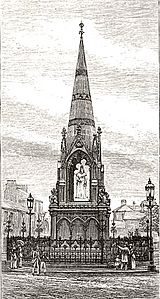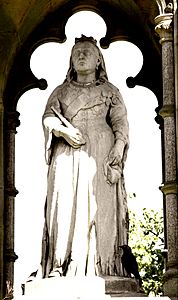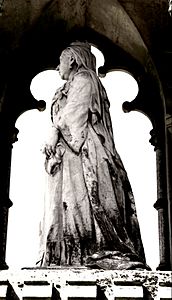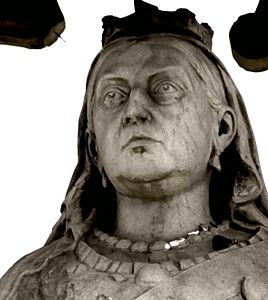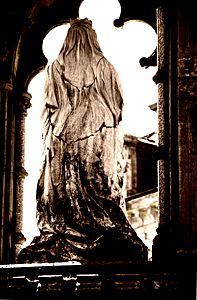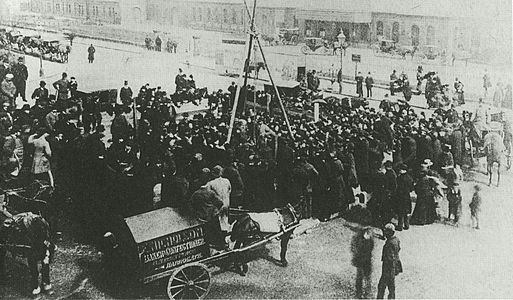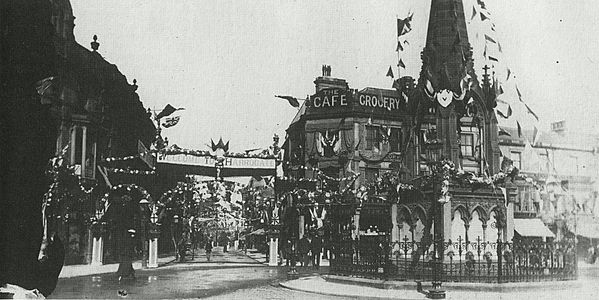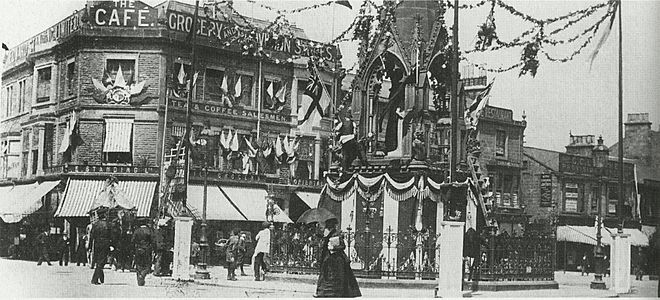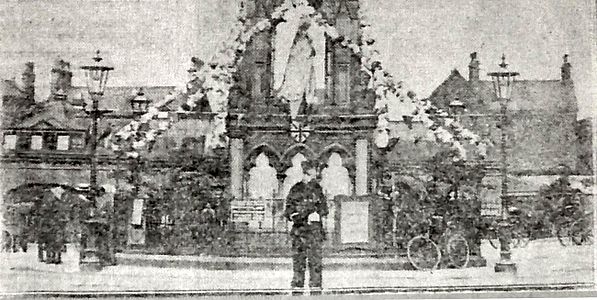Jubilee Memorial, Harrogate facts for kids
The Jubilee Memorial in Harrogate is a special stone monument. It's a Grade II listed building, which means it's an important historical building protected in England. This memorial celebrates Queen Victoria's 50 years as queen, known as her Golden Jubilee, in 1887.
The monument was a gift to Harrogate from its mayor, Richard Ellis. It was designed by an architect named Arthur Bown. The statue of Queen Victoria was created by sculptor William John Seward Webber. The memorial is made from sandstone and has three main parts, like floors. It also features granite columns and a beautiful Sicilian marble statue of the Queen. The bottom part has special messages carved into it, the middle part holds the Queen's statue, and the top is a fancy carved stone roof, shaped like a tall spire.
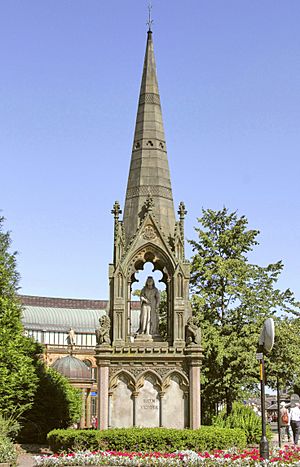 |
|
| Coordinates | 53°59′32″N 1°32′17″W / 53.9923°N 1.5381°W |
|---|---|
| Location | Station Square, Harrogate, North Yorkshire, England |
| Designer | Arthur Bown |
| Type | Gothic Revival shrine, reminiscent of the Albert Memorial |
| Material | |
| Width | 9.5 ft (2.90 m). |
| Height | 45 ft (13.72 m). |
| Beginning date | 14 April 1887 |
| Completion date | 1887 |
Contents
What Does the Jubilee Memorial Look Like?
This monument is a Gothic Revival style building. This means it looks like old churches and castles from the Middle Ages. It was designed by a local architect, Arthur Bown. The company Richardson of Scarborough built it. The statue of Queen Victoria was made by William John Seward Webber.
The main part of the monument is made from sandstone. The statue of Queen Victoria is made of Sicilian marble. The tall, round parts, called columns, are made from pink and grey granite from Scotland.
The memorial used to have "magnificent iron railings" around it. These railings were taken away during the First World War. This happened because the government needed iron for making weapons and other war supplies.
How Was the Memorial Created?
Planning and Funding the Memorial
People started planning this memorial to celebrate Queen Victoria's 50th year as queen in 1887. The first idea was to build a drinking fountain with a statue. However, they changed the plan to just a memorial and statue. This was because a drinking fountain "might have been a source of annoyance."
The spot where it stands was first shaped like a triangle. But they made it circular to allow more space for carriages. Mayor Richard Ellis gave the memorial to Harrogate. People also helped by donating money. Over 1,600 citizens gave money, some as little as a penny.
Laying the Foundation Stone in 1887
The first stone, called the foundation stone, was put in place on April 14, 1887. Mayor Richard Ellis's wife, Mary Jane Ellis, laid the stone. The weather was very cold and snowy, but a large crowd still came to watch. The Mayor and other important people were there.
Arthur Bown, the architect, gave the Mayoress a silver trowel and a mallet for the ceremony. Many speeches were given, and the crowd cheered a lot.
Unveiling Ceremony in 1887
The monument was officially revealed on October 6, 1887. The Marquis of Ripon did the honors. He arrived at Harrogate railway station and was met by the mayor. A big parade escorted him to the ceremony. It included police, a brass band, the fire brigade, and many local groups.
The station was decorated with flags. A huge crowd gathered around the monument. They cheered loudly for the Marquis. He gave a long speech, which was often interrupted by cheers. About a hundred important guests, including the sculptor Webber, were invited to a special dinner.
Prince Albert Victor's Visit in 1889
Prince Albert Victor visited Harrogate in 1889. He was Queen Victoria's grandson. He came to open a new part of the Royal Bath Hospital. For his visit, the Jubilee Memorial was decorated with garlands. At this time, it still had its "magnificent iron railings."
Queen Victoria's Diamond Jubilee in 1897
The monument was decorated again on June 22, 1897. This was to celebrate Queen Victoria's 60th year as queen, her Diamond Jubilee. A photograph taken that morning shows the temperature was quite warm. There was a parade through the town, and all the church bells rang.
Queen Victoria's Funeral in 1901
On February 2, 1901, the day of Queen Victoria's funeral, businesses in Harrogate closed early. People placed a wreath on the Jubilee Memorial. It was decorated with black and purple cloths. Other groups and people from the town also added more wreaths.
Visit of the Lord Mayor of London in 1913
On June 7, 1913, the Jubilee Memorial was decorated again. This was for the visit of the Lord Mayor of London, David Burnett. He came to open new parts of the Victoria Baths and the Old Sulphur Well. Burnett brought the state landau, a special carriage, with him on the train. He rode in it around town with the Mayor of Harrogate and many other important people.
What People Thought of the Memorial
On March 22, 1888, Prince Albert Victor visited the monument. He said he "warmly admired" how much the statue looked like his grandmother, Queen Victoria.
In 2012, a visitor to Harrogate noticed that the gardens around the monument were not being looked after very well.


